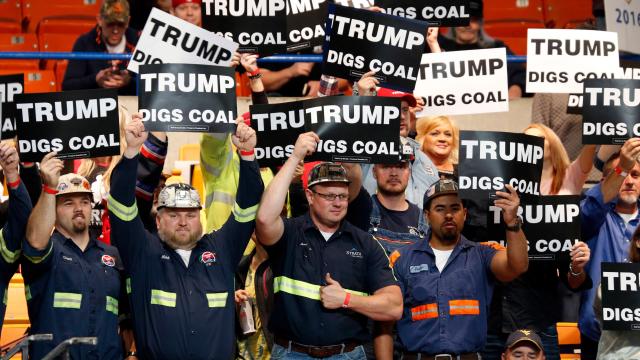Remember all of Donald Trump’s promises to put coal miners back to work? Turns out, his repeated attacks on the environment to try and bail out dirty fuels were all for naught. More coal-fired power was taken off the grid under Trump’s presidency than under former President Barack Obama’s second term, a new analysis from Global Energy Monitor shows.
Trump’s only been out of office for a couple months, but it’s kind of wild to remember just how hard Trump worked to do favours for the coal industry. In addition to rolling back more than 100 environmental regulations over the course of his term, let’s not forget how cosy he was with coal executives — and how his Department of Energy tried to check off items from a literal “wish list” of suggestions to save the industry from coal baron Bob Murray.
But the new report, which is the 2020 version of an annual release from Global Energy Monitor, a non-governmental organisation that keeps track of fossil fuels, has the cold, hard truth: A coal-friendly Washington was no match for the market forces that were dragging down coal, plus a pandemic in Trump’s last year that hit the industry hard.
“The fact that coal plant retirements under Trump exceeded Obama shows that coal is in structural decline in the U.S.,” Christine Shearer, the Program Director for coal at Global Energy Monitor, said in an email. “Coal simply cannot compete with lower-cost alternatives, even with a presidential administration that did everything in its power to increase coal use and prolong the life of coal plants.”
Over the four years Trump was in office, a total of 52.4 GW of coal-fired power was retired, compared to 48.9 GW in Obama’s second term. (Only 18 GW of coal power was retired under Obama’s first term.) This is a little different from the number of coal plants: 289 coal-fired units retired in Obama’s second term, versus 172 in Trump’s term. But those numbers alone don’t tell the story: “A lot of small coal units retired under Obama, and the units that retired under Trump were bigger on average,” Shearer explained.
Before you celebrate, there is some bad news on the global coal front. According to the report, the world actually added coal capacity development last year for the first time in five years, despite coal plants falling like flies in the U.S. and other countries. Most of this new development was in China, which commissioned 38.4 GW of new coal plants last year — 76% of the world’s total new construction.
China also added record numbers of renewable energy last year, Shearer said. But provinces attempting to use coal-fired power projects as a relief from the pandemic economic slowdown and relaxed regulations from the government meant that the number of new coal developments also spiked last year.
“The central government reforms discouraging coal power use have been incomplete and uneven across the country, resulting in high levels of commissioning for both renewable and coal power — effectively resulting in an ‘all of the above’ power strategy,” Shearer said.
Fortunately, Shearer said, much of the rest of the world is trending in the opposite direction as China builds out more capacity. “Countries in South and [Southeast] Asia like India, Bangladesh, Vietnam, Pakistan and Indonesia were all considered to be the next big hot spots of coal power growth, after China,” she said. “But what we are seeing is government after government in these countries roll back their coal plant plans, to the point that we don’t anticipate a rise in construction in any of those countries.”
As for the U.S., despite the rapid pace of retirements, there’s still room for more work. Per the report, there’s 233.6 GW of coal-fired power still on the grid; only one third of those active plants are currently scheduled to retire by 2035. Meanwhile, 141.1 GW of plants — more than half — have no set retirement date. Keeping up the pressure on coal plant retirements and accelerating the clean energy revolution that focuses on a just transition for coal workers could help the Biden administration beat one of the many records that Trump is undoubtedly embarrassed to have.
